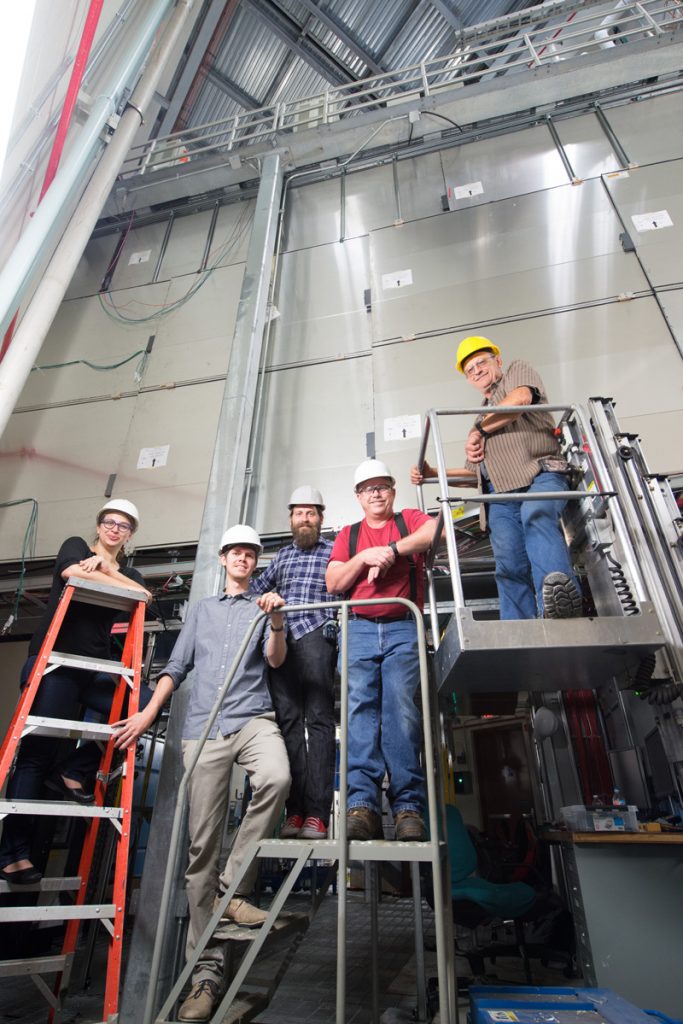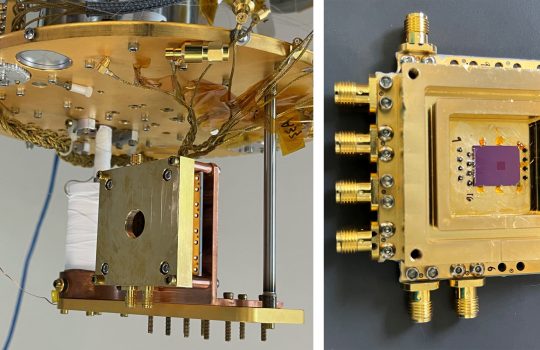Shining aluminum panels hang like heavy curtains on each side of the particle detector MicroBooNE at Fermilab. Thin wires run along the sides of each panel and are bundled together similar to a curtain with a cord.
Even though the heavy panels now block the view of the large detector in its solitary pit with their eye-catching sheen, they are not just decorative. They serve a critical purpose: spying on particles coming from cosmic rays before they hit the actual detector.

MicroBooNE’s shiny new exterior helps scientists identify cosmic rays masquerading as neutrinos. From left: Elena Gramellini, Thomas Mettler. Martin Auger, Mark Shoun, John Voirin. Photo: Reidar Hahn
The signals of cosmic rays
Cosmic rays are a constant rain of particles that are created in our sun or faraway stars and travel through space to our planet.
They’re subjects of many important physics studies, but for MicroBooNE’s research, they simply get in the way. That’s because MicroBooNE scientists are looking for something else — abundant, subtle particles called neutrinos.
Unlocking the secrets neutrinos hold could help us understand the evolution of our universe, but they’re exceedingly difficult to measure. Fleeting neutrinos are rarely captured, even as they sail through detectors built for that purpose.
Add to that the fact that their interactions are potentially drowned in a sea of cosmic rays rushing through the same detector, and you get a sense of the formidable challenge that neutrinos represent.
The MicroBooNE experiment starts with Fermilab’s powerful accelerators, which create neutrino beams that are then propelled through the MicroBooNE detector.
“The neutrino beam here at the lab gives us the right conditions to study neutrinos,” said Elena Gramellini, a Yale University graduate student on the MicroBooNE experiment. “Our challenge is to pick out neutrinos from many cosmic rays passing through the detector.”
Since cosmic rays are made of some of the same particles produced when a neutrino interacts with matter, they leave signals in the MicroBooNE detector that are often similar to the sought-after neutrino signals. Scientists need to be able to sort the cosmic rays in the MicroBooNE data from the neutrino signals.
Tagging and sorting
Even several feet of concrete enclosure would not completely block cosmic rays from hitting a detector such as MicroBooNE, not to mention that such a structure would be inconvenient and expensive. Instead, MicroBooNE uses the aforementioned panels, called a cosmic ray tagger, or CRT. While the panels don’t block cosmic rays, they do detect them.
Each CRT panel has particle-detecting components – strips of scintillator – that lie beneath its shiny aluminum enclosure. Cosmic ray particles can easily pass through aluminum and the scintillator — a clear, plastic-like material — on their way toward the MicroBooNE detector.
The cosmic ray particles deposit energy in the plastic scintillator, which then emits light. An optical fiber buried inside the scintillator captures the emitted light and transmits it to devices that generate the digital information that tells scientists where and when the cosmic ray struck.
“With our current layout of scintillator strips in each panel, we are able to tell precisely where the cosmic ray enters the MicroBooNE detector after it left the panel,” said Igor Kreslo, professor at the University of Bern who designed the CRT panels for MicroBooNE. “Our design effort really paid off and now ensures thorough cosmic ray tracking.“
So why the shiny aluminum shell? It blocks unwanted light from the detector’s immediate surroundings so that only light created by cosmic rays inside a CRT panel reaches the optical fiber and is detected.
Putting up panels
The 49 rectangular CRT panels are the contribution of the University of Bern in Switzerland, one of the 28 institutions collaborating on MicroBooNE worldwide. They produced the panels last winter and shipped them to Fermilab during the spring.
“This was a large project for us, and it took everyone in Bern to finish everything in time,” said Martin Auger, scientist at the University of Bern who planned the arrangement of the CRT panels. “A key moment was the test of the CRT panels after the long journey to Fermilab. All the panels arrived in good shape!”
The installation team overcame a number of challenges —including the tight space in which MicroBooNE stands — to successfully place the panels around the detector.
“The installation crew is a crack team of veteran Fermilab employees,” said John Voirin, who leads experiment installations at the laboratory. “In the end we have a very elegant, safe operating product that is a valuable asset to the experiment.”
Later this year the group will complete the installation by placing the final layer on top of the MicroBooNE detector. Even without it, the CRT already greatly enhances the capabilities of the experiment.
“We started taking data just in time for the first neutrinos delivered to the experiment,” Gramellini said.



